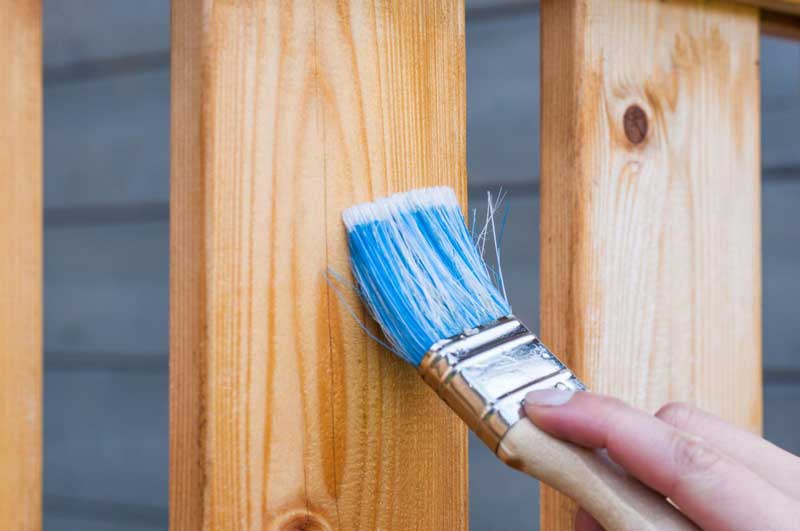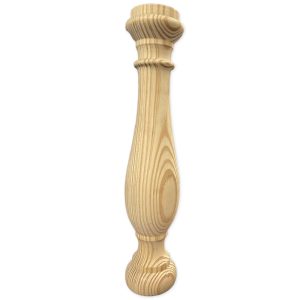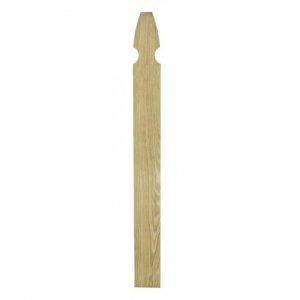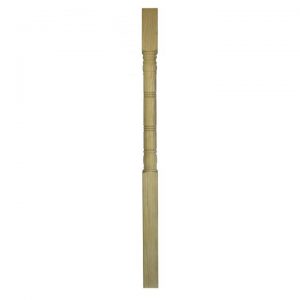Deck railing paint can fail prematurely. Luckily, there are several ways to prevent that from happening and increase the longevity of your paint. The following identifies some common reasons that deck railing paint fails, and some remedies to avoid it.
1. Wood was wet when it was painted.
Painting wood when it is wet or saturated may cause the paint to not adhere properly to the wood. To prevent this, make sure the wood is completely dry before applying paint. If only the surface of the wood is wet, then only one sunny day is usually needed for drying prior to painting. If the wood is saturated, several sunny or windy days are necessary.
2. Unfinished railings were exposed to several weeks of sunlight before painting.
Sunlight degrades the unfinished wood surface, meaning it will never hold paint as well as fresh wood. If the unfinished wood was exposed to sunlight for more than a few days, lightly sand or power wash the surface to remove the thin layer of degraded wood before applying paint. If power washing, be careful not to get the nozzle too close to the railing, as this can damage the wood. Taping a stick on the wand will force you to maintain a safe distance and prevent otherwise easily caused damage. You also have to wait for the railing to dry after power washing.
Tests of wood painted, or at least primed, before any exposure to sunlight show that the surface is not in need of repainting for at least 30 years. However, wood exposed to sunlight for 1 week prior to priming required repainting at 13 years, and wood exposed to 2 weeks of sun prior to priming required repainting a after just 10 years. Light sanding can remove the thin layer of damaged wood, and it is advised to prime immediately.
3. Temperature was too cold when the wood was painted.
Oil-based paints should be applied when the temperature is at least 40 degrees Fahrenheit. For latex paints, the temperature should be at least 50 degrees, and conditions should remain above these temperatures for 24 hours after painting. If pretreating the wood with a paintable water-repellent preservative (a recommended practice), best results are achieved if it is applied when temperatures are greater than 70 degrees Fahrenheit.
4. Wood was too hot when it was painted, or was heated soon after painting.
Do not paint wood when the temperature outside is higher than 90 degrees, as this may cause temperature blisters in the wood. Painting with white paint on a white surface can be okay any time of day because white generally reflects the sun’s heat. With colored paint, the best procedure is to “follow the sun” around the deck, although this presents a problem on the west side. The east side of the railing should be painted late in the morning, the south side in the middle of the afternoon, and the west side late in the afternoon, unless it gets full sun. If the west side of the deck receives full sun, it’s best to paint before noon. Additioanlly, the north side can be painted at any time during the day.
Keep in mind that at least 2 hours are needed for the fresh paint to dry before weather conditions cool to the point where dew forms. If blistering on the wood surface does occur, allow the paint to dry for a few days, scrape off the blisters, smooth the edges with sandpaper, and paint the area.
5. Weather was too humid when the surface was painted.
When water-based paints cure, the water should evaporate as fast as, or faster, than the solvents. After the water has evaporated, the paint will shrink to nearly its final shape. As the solvents evaporate, the paint chemically reacts to form a hard material. When it is too humid, water cannot evaporate and the solvents may evaporate first, causing the paint to cure while still in a water-filled state. You cannot recover from this type of disaster. Oil-based paints may also fail if conditions are too humid.
Additional Tips
Here are some more tips for getting the most out of your deck railing paint:
Wash railing before painting.
If the railing is dirty, the surface of the railing should be power washed or cleaned with detergent and a stiff bristle or brass brush and rinsed well. Never use steel or iron, which causes iron stain and may glaze the surface.
Never paint decayed or rotting wood.
Decayed wood can result if the wood has been wet for extended periods. If the wood is soft and spongy, it is degraded to the point that it will never hold paint and should be replaced. If there is only a small area of decay, it can be dug out. The remaining wood can be stabilized with a consolidate and the missing wood replaced with waterproof compounds. Be aware that wood shrinks when warmed because of loss of water and almost everything else expands-to be compatible, compounds must be and stay flexible.
By making sure the conditions are right when painting your deck railing, you’ll be able to maximize the longevity of the paint.
If you have additional questions on painting deck railing, don’t hesitate to contact us!









